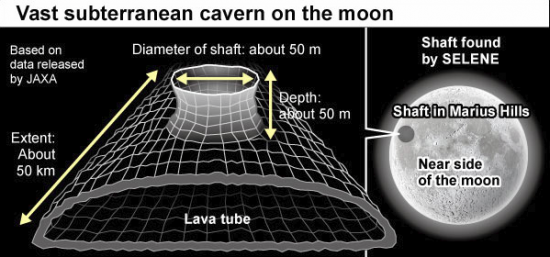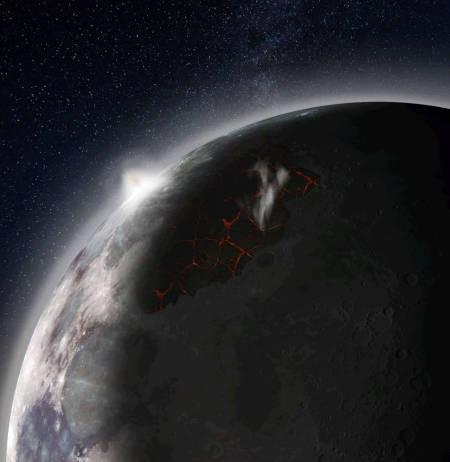October 19, 2017 – If humans are to return to the Moon to stay then the environmental challenges and hazards these first colonizers will face are many. Solar eruptions and cosmic rays on the lunar surface would be unavoidable without significantly hardened shelters in which the colonists would find some protection. And structures would also need to be sufficiently insulated to deal with the extremes in temperatures ranging from the daytime at 107 Celsius (224 Fahrenheit) to nights at -153 Celsius (-243 Fahrenheit) degrees.
Better yet would be the discovery of physical features on the Moon that could sufficiently serve both purposes. JAXA, the Japanese Space Agency, launched Selene in 2007 to take high definition images of the lunar surface. The 18-month mission ended in 2009 when Selene was deorbited and crashed onto the surface. The package onboard the orbiter included multi-band imaging of the lunar terrain as well as a radar sounder capable of examining underground structures.
Since its mission end JAXA has been studying the wealth of data collected by Selene and in the last week reported the discovery of a 50-kilometer (31-mile) cavern that could be an ideal place for humans to consider for colonization. Located in the Marius Hills on the Moon’s near side, the one facing us, the structure appears to be an empty lava tube with an entry shaft that is both 50 meters (over 160 feet) in diameter, and depth.

The lava tube may have been created 1 billion years ago during the last eruptive phase in the Moon’s geological history. The physical remnants of that time can be seen on the lunar surface and include this tube that, based on radar soundings, lies empty. What the radar soundings cannot tell us is if the tube contains water ice similar to what has been detected in lunar craters at the poles.
Which brings up another interesting lunar reveal of this last month, the announcement that the Moon not once but twice had a substantial atmosphere that lingered for millions of years before vanishing. These occurrences coincided with high periods of volcanic activity between 3 and 4 billion years ago. The physical evidence is seen in the extensive mare, or seas, vast basalt plains that cover much of the lunar near side. It is estimated that during peak eruptive periods the Moon’s atmosphere became as much as 1.5 times thicker than that which we find on Mars today, equivalent to 0.01 Earth’s atmosphere at sea level. The researchers even know the gases that populated the Moon’s ancient atmospheres and they are awfully familiar: carbon dioxide, water vapour, hydrogen, hydrogen peroxide, and sulfur dioxide. The absence, however, of a lunar magnetic field along with exposure to the solar wind, doomed the Moon to eventually lose its gas envelope to the point that today it is so low density that any gas molecules that still might seep from subsurface cracks escape into the surrounding space in short order. But the atmosphere that once existed leads to some intriguing questions.
If it lingered for millions of years in substantial enough amounts, can one speculate that it would have allowed liquid water to accumulate on the surface in some areas?
Could we then find evidence in the future of erosive water features similar to the ones Curiosity has encountered in Gale Crater on Mars?
And as on Mars, where we find evidence of water in the past, could there also have been, for a very brief period, life?









